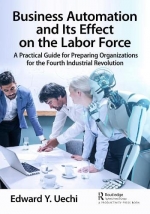Tab Article
The world is undergoing a transformation in what Klaus Schwab, founder and Executive Chairman of the World Economic Forum, calls the "fourth industrial revolution." Technological development made possible by smaller and efficient components will have the potential to create new computerized machines that can automate business processes in arguably all industry sectors. Not only would this advance manufacturing further, other industries that have never been thought to be candidates for automation such as construction, hospitality, and education can be automated in the near or distant future. New technological systems can be used to manufacture products and deliver services with greater productivity and efficiency. And now, with the deployment of machines comes the displacement of human workers.
Business Automation and Its Effect on the Labor Force: A Practical Guide for Preparing Organizations for the Fourth Industrial Revolution informs business managers on technological systems that can change their industries for the better. This book provides an easy-to-understand primer on the underlying technologies that are defining the fourth industrial revolution. Readers will be able to discern which technologies are ready to use and which are not. As a business management book, managers can use this book as a guide to plan and prepare for the future. A critical decision that will have to be made is in choosing between machines and humans to do the work that business entails. Recent literature argues how emerging technologies could change the nature of work to be so disruptive as to cause mass displacement of workers. This book contributes to the debate by identifying what jobs would be lost and what jobs could be created. Automation will indeed change the labor factor in production. But to what degree will be determined by the maturity of the technologies and by the decision of senior managers.
Business Automation and Its Effect on the Labor Force provides reviews of specific technological systems that have been developed for agriculture, manufacturing, construction, transportation and warehousing, accommodation and food services, health care, administrative and support, and educational services. The author makes forecasts on when the systems would be ready to be deployed. A timeline is provided showing which industries would be the leaders in adopting new systems and which ones would lag behind. For a number of reasons, certain industries will be slower to automate than others. The analysis of the technological systems is coupled with the economics of production. The first chapter provides the foundational knowledge to understand the cost and use of equipment and labor – the two major inputs of production. The last chapter, after describing the systems, applies the economics to find combinations of workers and machines that would be optimal for a particular organization. The book concludes with a discussion of the implications that widespread business automation across the economy could have for the labor force.


